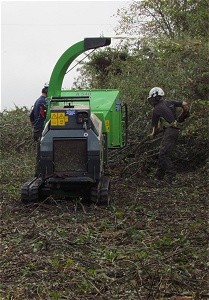Stockport Tree Surgeon – Hedge Laying for Stockport Council in Marple
 In Stockport, tree surgeon Myers Tree Care was contacted by Stockport Council to provide a price to cut and lay an overgrown Hawthorn hedge that was located on the top of a 15ft retaining wall at Seventeen Windows in Marple.
In Stockport, tree surgeon Myers Tree Care was contacted by Stockport Council to provide a price to cut and lay an overgrown Hawthorn hedge that was located on the top of a 15ft retaining wall at Seventeen Windows in Marple.
The hedge had not been cut for many years, as access for machinery was very restricted due to its height from the road level.
Other than general management of the hedge, the council’s engineers required the hedge getting back under control so that they could inspect and carry out any remedial works that might be necessary to the retaining wall.
The ancient art of Hedge Laying was historically undertaken by landowners to ensure that their property boundaries were ‘stock proof’ before the invention of barbwire and wire stock fencing.
This method of maintaining hedges is a very effective and efficient way of keeping them stock proof.
It’s sad to see this method of hedge cutting in decline and as a result, the general appearance of the British countryside is changing in an irreversible manner.
As an expert in tree care and management, David Myers feels that it’s up to proactive professionals to provide these services and keep this method of hedge management alive, advising clients of alternative methods for maintaining their hedges other than flail cutting etc.
Myers Tree Care practices the ancient art of Hedge Laying in Stockport
On acceptance of the contract of our services, we undertook flail cutting to the sides of the hedge to improve access into the base of the hedge. This made the job a little easier as the hedge was very top-heavy and required reducing in width to ensure it was laid correctly, made presentable and stock proof.
Starting at the highest part of the site and wall we started to lay the first few trees, which is often the most challenging as you need space to interlock into the neighbouring hedge etc.
Once the first few metres were in the correct position, the rest of the hedge will naturally interlock, if thinned and cut in the correct position.
After approximately 10 metres had been laid, stakes were added to the sides of the hedge to ensure that all material is interlocked and not wasted or cut out unnecessarily.
This process was repeated until we reached the far end of the hedge, any self-sown trees or un-wanted species within the hedge were also removed and their stumps treated.
All the thinning material was then chipped on-site and was left to rot down naturally.







